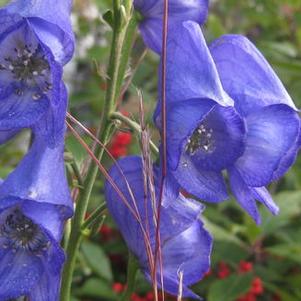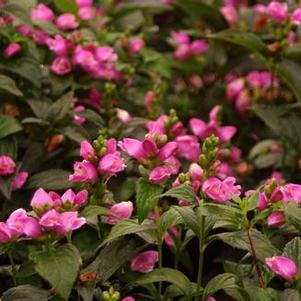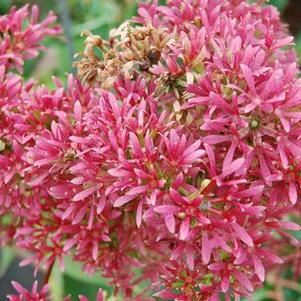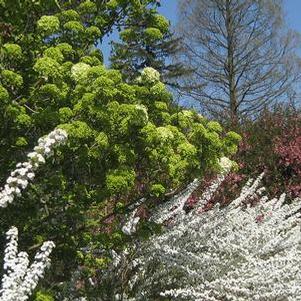Flowering Fall Favorites
With fall festivals, haunted hayrides, bonfire gatherings and shorter daylight hours upon us, the Nursery is once again beginning to brim with color. And we’re not just talking about the pending foliage changes on our various trees and shrubs (although that’s pretty great, too). It’s time to celebrate a few last hurrahs for our fall flowering favorites here at Pleasant Run. Now’s the time to be planting, and what better to use than some beautiful late bloomers to wow and intrigue onlookers? This week, we’re going to talk about five of our seasonal favorites that are currently showing us what they’ve got, starting with an oldie-but-goodie: Viburnum macrocephalum.
Maybe call us a little bit old fashioned, but Viburnum macrocephalum is one of those plants that remains a classic both in the landscape and in our hearts. This twice-blooming, deciduous Chinese shrub is a lovely, multi-seasonal addition to the specimen garden or foundation planting as a main visual component. Its attractive, vase-shaped form and soft, grey-green foliage becomes covered in large, profuse clusters of chartreuse-to-white flowers that first emerge in April to May, and then reappear in the early fall months. It is for these large, fluffy blooms that this shrub gets its common name, the Chinese snowball viburnum. Sterile and fragrance free, cut flowers make beautiful additions to fresh arrangements, and can also be dried for other projects.
But why work with one vase-shaped flowering woody specimen when you can have two? Known for its beautiful form, its eye-catching, finely exfoliating bark, fragrant white blooms and showy post-bloom flower bracts, Heptacodium miconioides might be one of the most heinously underutilized ornamental woodies in the trade. Not only is its botanical name fun to say, but its common name, seven-son flower, helps to clue you in to the unique appearance of the inflorescences: each pleasantly fragrant, creamy white floral cluster typically produces seven individual flowers. Following its bloom period, showy flowers are replaced with even showier reddish-rose-pink fruits and calyces that persist on the tree throughout much of the fall. As with Viburnum macrocephalum, the seven-son flower tree is also a Chinese native, and is fairly adaptable to a wide range of soil conditions. Notoriously difficult to track down in the trade, we have a handful of these babies available in #10’s, each of which is just begging to be someone’s new favorite tree.
Now, you can’t have a specimen garden without some fun perennials to jazz up the base of your large, spectacular ornamental woodies, so might we recommend some fall flowering options? Since you’re in the process of wow-ing audiences with your rare and unique finds, add a further touch of whimsy to the landscape with Chelone obliqua Tiny Tortuga™ and its fascinating, snapdragon-like inflorescences. Tempting to both curious children and likeminded adults, the hot pink blooms reminiscent of turtle’s heads beg to be made to talk like tiny sock puppets. Butterflies and various bee species also delight in the native nectar of this dark-leaved perennial, diving in and out of the floral openings and wiggling their fluffy bodies within the internal cavities of each flower. While this species naturally prefers soil conditions that are more on the side of moist to wet, it will also make a suitable addition to a perennial border with average soils, and can also be included as an unexpected container specimen. Check out the attached timelapse pictures of a honeybee exiting a Tiny Tortuga™ turtlehead bloom!
Naturally, you’re going to need some contrast to balance out all of the warmer tones that you’ve just incorporated into your garden – the bright, sapphire indigo-blue of Aconitum carmichaelii ‘Arendsii’ is ready to provide with exactly that. The tall, upright stature of these remarkably blue flower spikes makes this plant not only a wonderful background perennial for the border, but is also sure to inspire intrigue and wonderment amongst audiences. Similar to turtlehead flowers, the large, open blossoms of monkshood beckon fluffy bees to venture within to gather their sweet prize. One could make a mystical afternoon from watching bees hungrily explore the brightly colored, hooded flowers, with their tiny yellow bodies juxtaposing complimentarily against the stark blue of the petals.
Chinese snowball viburnum - FineGardening
How to Grow and Care for Chinese Snowball Viburnum (thespruce.com)
Heptacodium miconioides (Seven Son Flower) (gardenia.net)
Heptacodium miconioides - Plant Finder (missouribotanicalgarden.org)
Chelone obliqua Tiny Tortuga™ 'Armitpp02' turtlehead from North Creek Nurseries

Heptacodium miconioides





